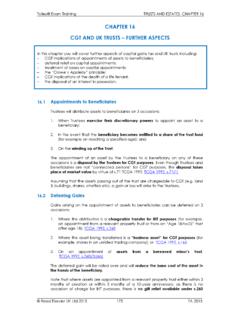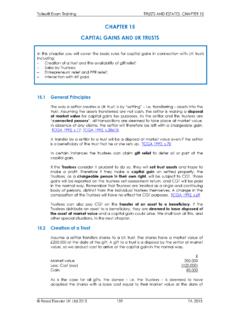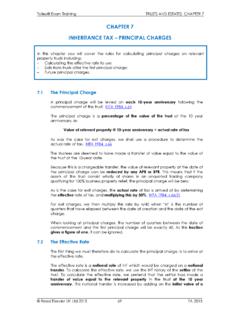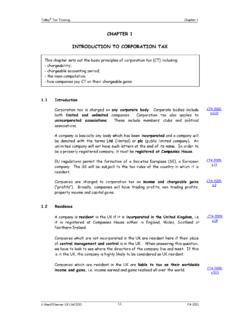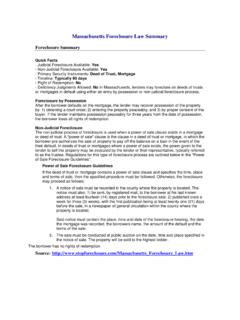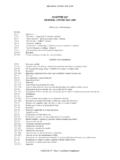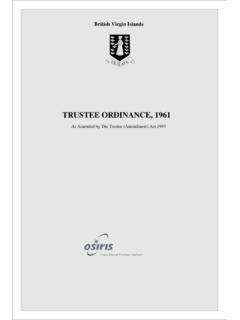Transcription of CHAPTER 12 INTEREST IN POSSESSION TRUSTS – IHT ISSUES
1 Tolley Exam TrainingTRUSTS AND ESTATES CHAPTER 12 Reed Elsevier UK Ltd 2015121FA 2015 CHAPTER 12 INTEREST IN POSSESSION TRUSTS IHT ISSUESIn this CHAPTER you will cover the IHT implications of INTEREST in POSSESSION (IIP) TRUSTS including: The definition of an INTEREST in POSSESSION ; TRUSTS created before and after 22 March 2006; Qualifying interests in POSSESSION ; Apportioning tax payable between Executors and Trustees; Immediate post death interests; Transitional serial term INTEREST in POSSESSION has no statutory definition.
2 Following the case of Pearson v CIR, it is widely recognised that the term INTEREST in POSSESSION broadly means a present right to present enjoyment of income .This means that if a beneficiary, at this moment in time, has power to enjoy the income of a trust , he or she will have an INTEREST in Press Release 12 February 1976 sets out their understanding of the term INTEREST in POSSESSION . An INTEREST in POSSESSION in trust property exists where the person having the INTEREST has an immediate entitlement to any income produced by the property in the trust .
3 IRPR the Trustees have a discretion or power to withhold income from that person, such a power will negate the existence of an INTEREST in POSSESSION . Therefore if the trustees have a power to accumulate income within the trust , no INTEREST in POSSESSION will INTEREST in POSSESSION will exist where a beneficiary has a present right to enjoy the income of the trust . Therefore if the trustees have power to remove future income, this does not negate the existence of a current INTEREST in exclusive right to enjoy an asset within a trust , is also an INTEREST in POSSESSION , even if that asset does not produce any income.
4 HMRC Press Release 15 August 1979 states that if Trustees permit a beneficiary to occupy a dwelling house at less than full commercial rent, this will create an INTEREST in POSSESSION . This has inheritance tax Act 2006 Finance Act 2006 made significant changes to the inheritance tax treatment of INTEREST in POSSESSION TRUSTS . These changes took effect from 22 March 2006. Since 22 March 2006, if an individual creates an INTEREST in POSSESSION trust during his or her transfer is immediately chargeable to inheritance tax; and Tolley Exam TrainingTRUSTS AND ESTATES CHAPTER 12 Reed Elsevier UK Ltd 2015122FA assets within the trust are relevant property and are therefore subject to exit and principal charges.
5 This was not the case for INTEREST in POSSESSION TRUSTS set up before March 2006 as we shall Relevant Property v Qualifying IIP To understand the inheritance tax treatment of INTEREST in POSSESSION TRUSTS , we need to be able to differentiate between relevant property and qualifying interests in POSSESSION .In broad terms, relevant property is property which is not comprised in the estate of a settlor or a beneficiary. In order to ensure that such assets are not therefore outside the scope of IHT, relevant property is subject to exit and principal trust assets are held on qualifying INTEREST in POSSESSION , such assets ARE comprised in the estate of a beneficiary.
6 Therefore, where a beneficiary is a life tenant of a qualifying INTEREST in POSSESSION trust , the trust assets form part of his death qualifying IIPs are already within the scope of IHT, property within a qualifying IIP is not subject to exit and principal Act 2006 changed the rules such that not all life tenants of IIP TRUSTS are now treated as having a qualifying IIP . Taxation of a Qualifying INTEREST in PossessionThe term qualifying INTEREST in POSSESSION is used to describe: IHTA 1984, (1) in a trust for a disabled person; in an IIP trust created on death; and in a lifetime IIP trust created before 22 March 2006.
7 INTEREST in POSSESSION TRUSTS created during the lifetime of the settlor before March 2006 were potentially exempt transfers. IHT was only chargeable if the settlor died within 7 years of setting up the trust . IHTA 1984, (1)Assets settled on qualifying INTEREST in POSSESSION TRUSTS are treated as being part of the estate of the beneficiary with the INTEREST in POSSESSION (the life tenant). IHTA 1984, such assets are taxed in the beneficiary's death estate, qualifying IIPs are not subject to exit and principal an individual dies with a qualifying INTEREST in POSSESSION in a trust , the trust assets will form part of his death estate.
8 The value of a qualifying IIP must be declared by the Executors on the death estate return (form IHT 400).If the beneficiary only has an INTEREST in part of the trust fund, the same proportion of the assets in the trust is deemed to form part of his held by the deceased in his own right personal assets etc make up his free estate . We value the free estate, deduct any liabilities and then add the Tolley Exam TrainingTRUSTS AND ESTATES CHAPTER 12 Reed Elsevier UK Ltd 2015123FA 2015value of a qualifying IIP to the assets in the free estate.
9 This total amount will be charged to IHT. Value of free estateAValue of qualifying IIP BChargeable to IHTC In essence, even though the life tenant was only entitled to the income of the trust during his lifetime, on his death we pretend that the capital assets which form the qualifying IIP are part of his estate for IHT purposes. Illustration 1 Peter died in March 2016 having made no lifetime transfers. Peter left a free estate (personal assets etc) worth 500,000 entirely to his son. Peter was also the life tenant of an IIP trust created in 1995.
10 The assets of the trust were worth 300,000 at Peter's the trust was created before 22 March 2006, the trust is a qualifying IIP . The trust assets will therefore form part of Peter's death remainderman of the IIP trust is Peter's daughter. This means that on Peter's death, the assets of the trust will pass automatically to his the IHT due and show who will be responsible for paying it. Finally, calculate the the amount Peter's daughter will IHT is calculated as follows: Free estate500,000 Qualifying IIP300,000 Total chargeable estate800,000 Less: Nil band(325,000)Taxable475,000 IHT @ 40%190,000 Peter's Executors will only pay IHT on assets forming part of the free estate.


